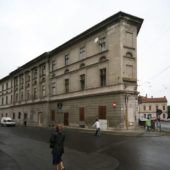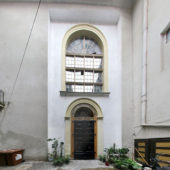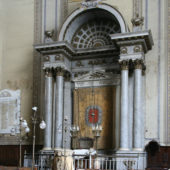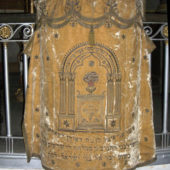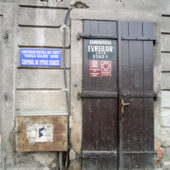A unique triangular, donut shaped building with the sanctuary entrance from a courtyard in the center of the donut.
Located in Arad’s historical Jewish quarter, this remaining synagogue is one of two that served a once-thriving Jewish community in this city in far western Romania.
Built in 1834, the Arad Synagogue was constructed in neo-classical style in an unusual, triangular shaped, 3-story building. Access to the synagogue is gained from a small, open courtyard located in center of the building.
A large, arched window dominates the wall on the south side of the synagogue, flooding the 3-level interior with daylight and calling attention to other neo-classical details, such as the Corinthian capitals on the columns framing the Aron-Kodesh and, more conspicuously, the vaults and dome above.
A rosette featuring the Mogen David, or Star of David, is painted at the top of the dome, surrounded by twelve painted “windows” whose scenes have since faded, but whose blue color suggests openings to the sky above.
The vaults, dome and pillars are ornately trimmed with blue and gold floral designs and, in places, decayed and missing plaster has exposed underlying structures. Wooden benches for congregants feature on both the main floor and second floor gallery.
This synagogue was founded in the 19th century as part of the Neolog reform movement in Judaism. This modernizing movement sought to change traditional worship rituals, which included introducing the use of high German during worship services. The movement also welcomed the use of the pipe organ, and the Arad Synagogue contains an organ on the second floor gallery.
In Arad, Neolog movement was led by Rabbi Aaron Chronin who oversaw worship services in the city from 1789 until 1844. Other ritual changes included relaxing dietary and Sabbath travel restrictions. Jews with a more Orthodox preference attended Arad’s other synagogue, also located in the quarter.
Arad eventually became the center of one of Romania’s largest Jewish communities with more than 10,000 in the days leading up to World War II. Most of these Jews survived the war and later migrated to Israel, leaving behind only a remnant population that continues to gather at the synagogue (which also serves as a venue for classical music concerts).
Today (2009), about 300 Jews remain in Arad and the synagogue doubles as the city’s Jewish Community Center as well as housing Rabbi Chronin’s mausoleum. The Jewish community has joined with a conservator to begin restorations.

